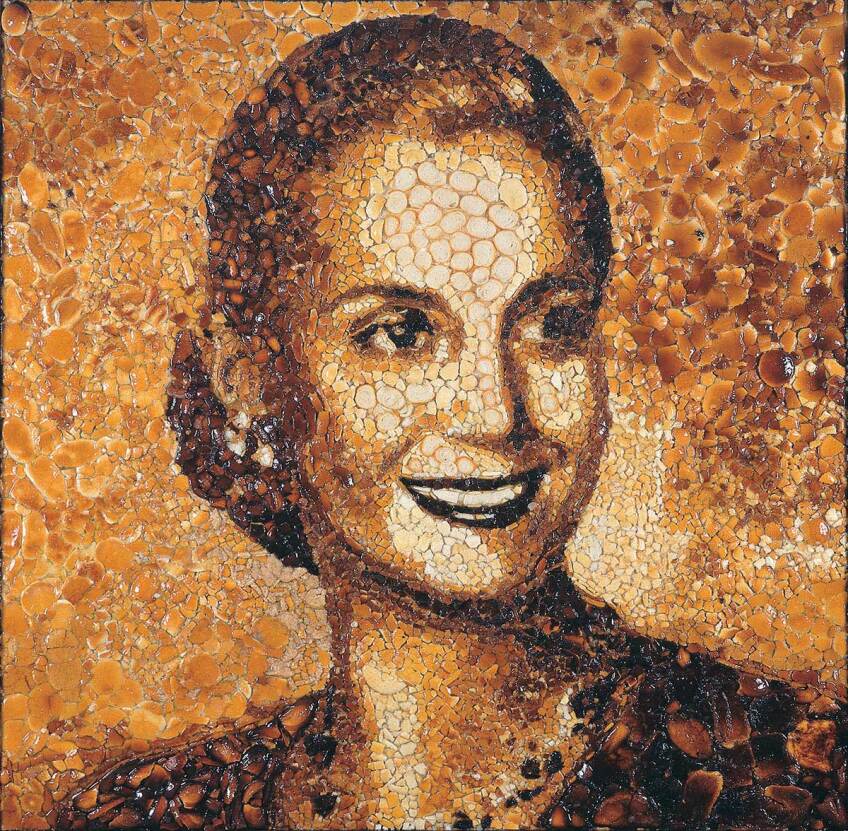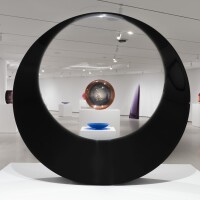Argentinian Art Collective Explores Unusual Materials in Their Epic Works

In 2001, as rioters in Argentina looted supermarkets, Juliana Laffitte and Manuel Mendanha of the Argentine art collective Mondongo began making art from cold meat cuts: portraits of an autumnal landscape, a naked woman seated on a bed.
“We had a big crisis in our country,” Mendanha said. “Half of the population was under the line of poverty. There was no food. So we decided to do paintings with the most valuable thing we have in our country, which is meat.”
Laffitte and Mendanha married 20 years ago, soon after meeting during their fifth and last year at the Escuela Nacional de Bellas Artes Prilidiano Pueyrredón in Buenos Aires, where they now have a studio. In 1999 they formed Mondongo. A third member, Agustina Picasso, was with them from 2000 to 2009.
Bullets, chocolate, nails, bread, matchsticks, cheese and other unusual materials compose their art, which has reached cities including Madrid, Rome, London, Dubai and Buenos Aires, where their last show in 2013 drew around 100,000 people, Mendanha said. The exhibition included their epic “Argentina” landscape series, created over five years.
Click through a slideshow of their epic artworks using strange materials below:












Their latest exhibition, titled “What Are We Gonna Say After Hello?,” will run at the Track 16 gallery of the Bendix Building in the Los Angeles Fashion District through April 7.
The exhibition includes past works: the artists displayed the plasticine piece “Babies” (showing the couple’s ten-year-old daughter, Francisca, at five months), from their Sculptures of Gothic Arch series. It represents the plague of human beings destroying the world, according to the artists.
The artists covered three walls with floor-to-ceiling prints of “Argentina,” a sweeping plasticine series of dense landscapes in the Argentinean province Entre Rios. There, the rise and fall of water, the death and rebirth of trees are a metaphor for their country, Mendanha said. The original 15 panels were last displayed at the MAXXI museum in Rome in 2016, and may next tour Brazil in 2019.
The exhibition also featured a one-hour performance last Feb. 10 and 22.
In the opening-night performance on Feb. 10, two actors wearing gold and silver Pinocchio masks, symbols of lies, alternately pinned each other’s head down with a foot and embraced, then stopped to clean padlocks and keys. The power struggle prompts the question, “How can we surpass this situation and be better to each other?” Mendanha said of this piece.
The theme is reflected in a plasticine image of two boats caught on the ferocious edge of a whirlpool, inspired by the Edgar Allan Poe short story “A Descent into the Maelstrom.”
Mondongo created the piece, along with small paintings of fires also on display, over the last two months at their rental home in Echo Park — the first time they’ve made art outside their studio in Buenos Aires.
“It was a challenge, but on the other hand, it was very interesting because we are trying to do things in another place to change our thinking,” Mendanha said. “We are always trying to talk universally, but (also) talk about our issues in our country. Now we are trying to figure out what we are going to say if we live in another place, if we work in another place.”
Art imitates life
Mondongo uses friends and family as models in their work, even when they pull inspiration from dark fairy tales, such as the version of “Little Red Riding Hood” in which the wolf rapes and eats the child. The story’s protagonists appear in their “Red Series.” The girl in the series was modeled after Picasso’s daughter.
“The mix of different cultures and all the craziness” of L.A. sparked a series of 12 skulls, they said. The wood pieces contain busy plasticine scenes with animals, cartoon characters, historical places and people (Jesus, Hitler), events (The Last Supper), famous artwork (Mona Lisa).
Click through Mondongo's series of skulls, which contain an unbelievable amount of detail, below:












Their childhoods have also provided themes for their art.
Laffitte, the daughter of an Evangelist leader, witnessed weekly exorcisms as a child. During the rituals, exorcists commanded the Holy Spirit to remove demons with the words que los atrapan (trap them), she said.
The fire paintings at the Track 16 exhibition represent the Holy Spirit.
Mendanha was a child in the 1970s when he and his family fled the violence of the Argentine dictatorship. Dissidents were tortured and killed or thrown from aircraft, sometimes in trash bags, to their deaths in the waters of Rio de la Plata and the Atlantic Ocean. From birth until he was seven years old, Mendanha and his family hid with the indigenous Mapuche tribe in southern Argentina and in churches. The family returned to Buenos Aires after democracy was restored.
Rio de la Plata often appears in their work: a dark river of trash bags in one piece, a red-tinged marina on the river with bodies in another.
The troubles in their native country — injustices, poverty, violence against women — populate their art.
In “Dream of Reason,” a girl in underwear and a t-shirt lies facedown on grass. The work was triggered by the 2006 murder of a girl whose body was found at the Pereyra Iraola Park next to the Republica de los Niños theme park in La Plata, Argentina. The piece was also a reaction to the high rate of femicides in Argentina, and a justice system slow to punish the murderers, Laffitte said. The issue recently prompted the “Ni Una Menos” (Not One Less) movement to end gender-based violence in the country.
“Now, there’s a lot of movement with women’s (rights). But when we did this piece ten years ago, nobody was talking about that,” Mendanha said. “We never have been interested in revealing the name of the victim because it was only a trigger to address this topic, and we aspire that the work will help to formulate questions beyond where they come from.”
Arte Mondongo
As a teen, Mendanha joked with friends that he should make arte mondongo, referencing a polarizing stew made from the stomach lining of cows, pigs or sheep.
“We prefer people love what we do or hate what we do,” he said.
That stance led to works like a portrait of Pope John Paul II made with communion wafers, Internet pornographic scenes shaped from cookies and an oversized dollar bill studded with 30,000 nails.
The food art is preserved with a coating of resin. This technique was used in works such as "Alone, woman bathing," inspired by Rembrandt's painting "Bathing river,” and “Siobhan at home, naked,” inspired by the Nan Goldin photo “Siobhan in the A. House.” The preservative cannot prevent changes in the appearance of meat.
Over time, beneath the translucent resin, its tawny colors shift to white and air bubbles form.
“It’s like a painting that has a life,” Mendanha said. “As the years pass, it changes a little bit, very slowly. It’s like a ghost that is coming inside the piece.”


Mondongo no longer searches for new art materials.
“We were looking for a way to attract the attention of people and communicate with them,” Laffitte said of the experiments. “The final goal for us is to communicate with people.”
They now work mainly with plasticine, which allows them to sculpt and paint at once, and cotton threads. They first used threads to create a series of images of themselves making love.
“It was in a period, ten years ago, when we had no ideas,” Laffitte said. “We decided to take us as subject matter.”
In the process, Laffitte conceived their daughter and was pregnant when she and her husband showed the series at the Track 16 gallery at a former location, Bergamot Station in Santa Monica.
“It was very shameful for me, very difficult to show it,” she said of the personal images. “But with the belly, it was easier.”
Mondongo’s thread art includes a portrait of the late art critic Kevin Power, a former deputy director of the Reina Sofia Museum in Madrid, Spain who championed the young artists’ early work.
The swirling threads of the portrait form facial lines, wiry gray hair, glassy blue eyes and a melancholic expression. Fittingly, the subjects of Mondongo’s intimate thread portraits — “psychological portraits,” Laffitte calls them — are usually their friends.
“The cotton thread portraits generally are people who we love. We are sentimentally involved,” she said.
The craft requires both artists to work at the same time.
“When we started to develop this technique, we fought a lot,” Mendanha said. “But now, after ten years, we work without talking.”
The artists often exchange ideas for their work with friends.
“We are never alone,” Laffitte said.
“Our studio is an open place,” Mendanha said.
Fashion designer Rei Kawakubo, founder of Commes des Garcons and Dover Street Market, had never met the artists before she featured their work in the brand’s 2008 advertising campaign. During the collaboration, Laffitte and Mendanha corresponded with the famously reticent Kawakubo via email before meeting her for the first time in London at the end of their yearlong partnership.
“Working with her changed the way we look at fashion,” Mendanha said. “Before we worked with her, we didn’t see fashion as an art form.”
Catalan singer-songwriter Albert Pla recently tapped the duo to create the sets for his multimedia show “Miedo” (fear in Spanish)—another unexpected turn.
“We were very lucky knowing these people, and those things helped us to borrow the boundaries between different disciplines,” Mendanha said. “That’s the key of our work. We’re open to doing new things.”
Top Image: Mondongo, Skull series, 2009-2013 | Courtesy of the artists





